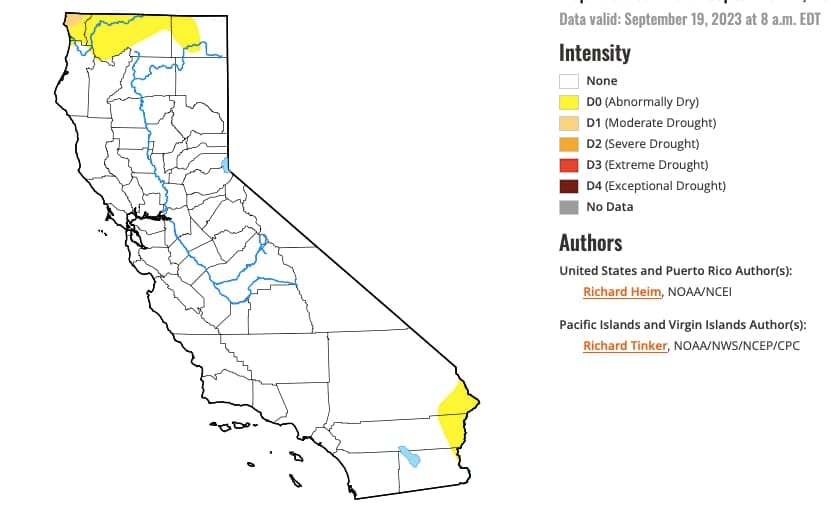SACRAMENTO, Calif. (CN) — Less than one week until California’s new water year begins, experts say the state is nearly free of drought — but there is no guarantee that another wet winter is soon to arrive.
The state, according to the Sept. 19 U.S. Drought Monitor, is 93% free of drought, a big improvement since measuring at 72% drought-free three months ago.
Only small regions of drought remain along the state’s southeast corner bordering Arizona and in the northernmost region at the Oregon border.

However, experts warn the full scope of recovery from several years of drought will not be known until a report in early April to assess the 2023-2024 snowpack.
Daniel McEvoy, associate researcher at the Western Regional Climate Center’s Desert Research Institute, said in a webinar Monday that while it is good to see much of the western U.S. out of drought, the coming winter will be key to see if that progress holds.
“There isn't really a clear signal yet as to what this coming wet season will do in terms of going into or staying out of drought,” McEvoy said.
He said after the wet winter, drought conditions returned in early summer only to be done in by sudden late summer storms like Hurricane Hilary, causing some regions such as Southern California to record the wettest summer on record.
The late-season storms also helped keep soil moisture at record high levels in areas that really needed it. This bonus combined with the help of lower evaporative demand — which means less moisture lost as water evaporates into the atmosphere, thanks to lower temperatures, high humidities and more cloud cover this year.
Those conditions mean that “the weather and climate have been in our favor for a quiet fire season,” he said. The only exception so far has been the Smith River Complex, which has burned more than 94,000 acres but is 85% contained.
More good news: McEvoy said that all major reservoirs, outside of the Colorado River and Lake Mead, are in good shape thanks to the winter’s deep snowpack.
In California, the only basin of some concern is Trinity Lake in Northern California, which is at 85% of average and 53% of capacity and should be monitored. And it will take multiple years of very wet conditions to improve the deeply strained Colorado River basin system, he said.
Scientists are also warning that El Niño may contribute to a rise in global land and ocean surface temperatures. El Niño is a naturally occurring weather phenomenon that oscillates with its opposite, La Niña. El Niño periods can last several years and are associated with heat and unpredictable weather.
The NOAA Climate Prediction Center’s director David Dewitt said El Niño may help drive above-normal precipitation in the southwestern U.S., and peaking sea surface temperatures. That in turn could mean increasing global land temperatures — a bad sign when global temperatures have already broken records this year. The planet saw its warmest three-month period on record after El Niño emerged and injected even more heat into the warming planet's atmosphere, the European Union's climate agency said this month.
Dewitt said El Niño is likely to keep affecting the globe through next spring, and temperatures are expected to stay above normal on the West Coast and the country's northernmost states from October through January. The southernmost third of the country has a “modest chance” of seeing more precipitation than normal, including in Arizona and Southern California.
“Every El Niño has been different,” Dewitt said.
Dry weather is expected throughout much of Northern California for the next week, though forecasters said in a discussion released Monday that precipitation is expected in the Sierra Nevada mountain range by the weekend.
“This precipitation is expected to be a mix of rain and snow, with snow falling above 8,000 feet, and rain falling below 8,000 feet,” the forecasters said.
Subscribe to Closing Arguments
Sign up for new weekly newsletter Closing Arguments to get the latest about ongoing trials, major litigation and hot cases and rulings in courthouses around the U.S. and the world.









